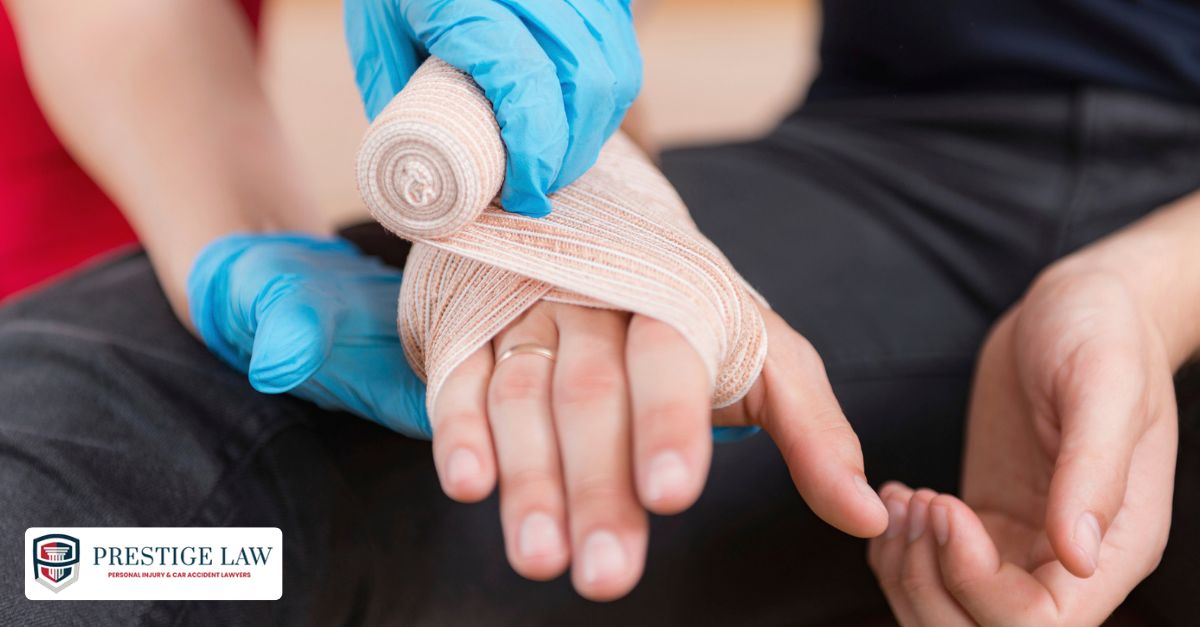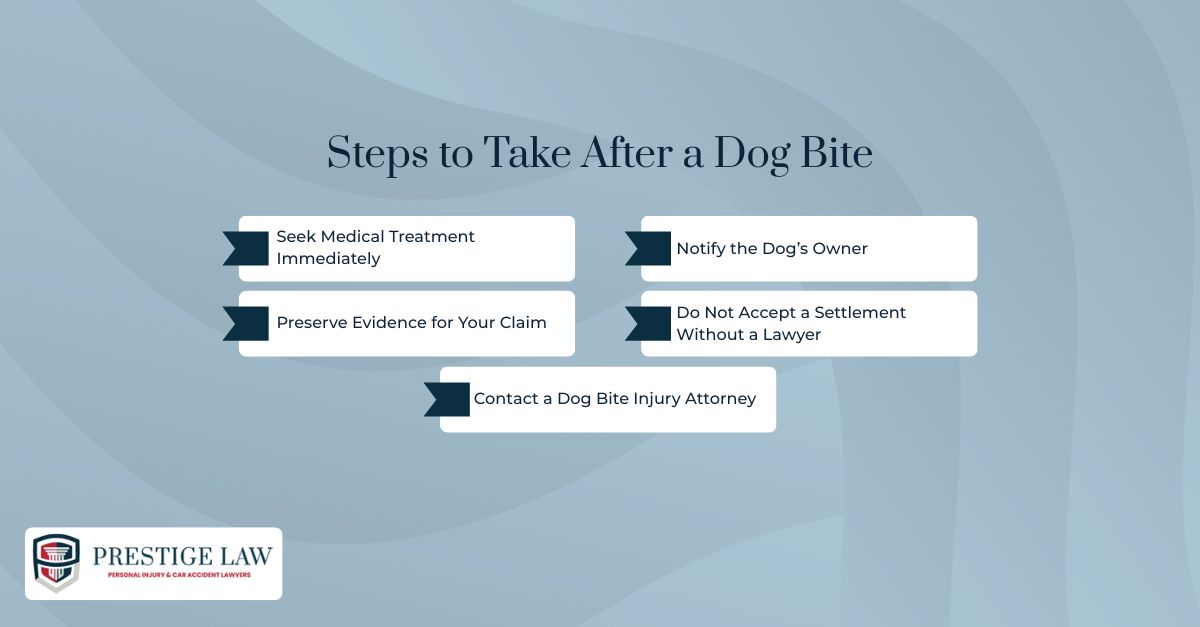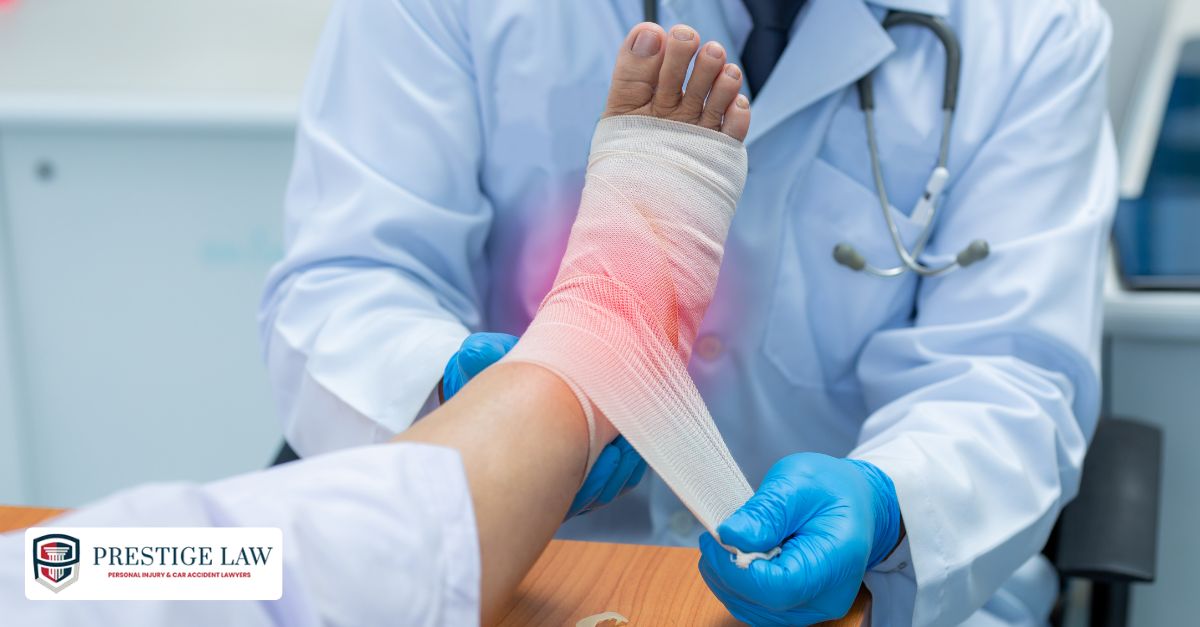
Dog Bite Injury Levels and California Law
Published on / Category: Personal Injuries
A dog bite can do more than break the skin. It can lead to painful medical treatment, missed work, and emotional trauma that lingers long after the attack. In California, the severity of the injury plays a big role in what your legal case might look like.
That’s where dog bite injury grades come in.
Using systems like the Dunbar Dog Bite Scale, medical professionals—and lawyers—can better understand how serious the injury is and how it affects your right to compensation. The higher the level, the more complex your recovery, and the stronger your legal claim.

At a Glance:
Dog bites are classified into six levels on the Dunbar Scale, ranging from no-contact warnings to fatal attacks. The severity of your injury directly affects your legal case, including liability, evidence strength, and compensation. In California, dog owners are strictly liable, so if you’ve been bitten, especially at Level 3 or above, you may be entitled to significant compensation. Always seek medical care, document everything, and contact a personal injury lawyer before accepting any settlement. Prestige Law Firm P.C. offers free consultations.
What are dog bite injury grades?
- Whether the injury poses infection or long-term risks
- What kind of legal or financial response might be appropriate
One of the most commonly used systems is the Dunbar Dog Bite Scale, created by veterinarian Dr. Ian Dunbar. It ranks bites on a scale from Level 1 (no skin contact) to Level 6 (fatal attack).
Each level reflects the dog’s behavior and the physical harm caused. But the scale is also important for establishing liability, strengthening your legal claim, and calculating potential compensation.
The Dunbar Dog Bite Scale: Levels 1–6 Explained
Dr. Ian Dunbar’s Dog Bite Scale is widely used by veterinarians, trainers, and legal professionals to classify dog bites based on severity. It ranges from Level 1 (no contact) to Level 6 (fatal injuries)—and understanding your level can help you and your lawyer build the right case.
Let’s break down what each level means:

Level 1: Aggression Without Contact
The dog growls, lunges, or snaps—but doesn’t touch skin.
There’s no physical injury, but the behavior is a warning sign. It shows poor impulse control or socialization and can signal future risk. Owners who ignore Level 1 aggression may be held accountable if it escalates.
Level 2: Skin Contact, No Puncture
The dog’s teeth touch the skin but don’t break it.
There may be light bruising or shallow scrapes. These “warning bites” are often attempts to intimidate rather than injure—but they still show that the dog is willing to use its teeth. They can be traumatic, especially for children.
Level 3: Shallow Punctures
The bite breaks the skin with one to four punctures, none deeper than half the length of the dog’s canine teeth.
These injuries may result from a quick bite-and-release or reflexive movement. Medical treatment is usually needed, and at this level, legal claims often become much stronger.
Level 4: Deep Punctures and Tissue Damage
This level involves one or more punctures deeper than half the canine tooth length, plus bruising, tearing, or laceration.
The dog may have bitten and shaken its head, causing serious damage to nerves, blood vessels, or muscle. These bites show clear intent to harm—and legal action becomes critical for both victim protection and community safety.
Level 5: Repeated or Mutilating Attacks
The dog delivers multiple Level 4 injuries in a single attack.
Victims may face disfigurement, permanent disability, or long-term medical treatment. Dogs at this level are often deemed highly dangerous. Lawsuits are likely, and owners may face liability, insurance issues, or legal sanctions.
Level 6: Fatal Attack
The bite leads to the victim’s death.
This is the most extreme and tragic level. These attacks typically involve destruction of major blood vessels, organs, or bone. Wrongful death claims may apply, and legal consequences for the owner are severe—including the possible euthanasia of the dog.
How Injury Grades Affect Your Legal Case
The more severe a dog bite, the stronger the potential legal claim. Injury grades play a big role in determining fault, liability, evidence strength, and how much compensation you may receive.
Let’s break it down:
Liability and Negligence
In California, dog owners are usually strictly liable for injuries caused by their pets—regardless of prior behavior. That means if the dog bites someone in a public space or where the person had a legal right to be, the owner is responsible.
However, the severity of the injury matters. A Level 1 or 2 bite might not justify a major legal claim. But a Level 3 or higher—especially with medical treatment, permanent scarring, or missed work—can clearly point to negligence or a failure to control a dangerous animal.
In more severe cases, the owner may also be liable for:
- Violating local leash laws
- Failing to secure a known aggressive dog
- Ignoring previous bite warnings
Strength of Evidence
The more serious the injury, the more evidence is needed—and often easier to gather. This can include:
- Medical records and bills
- Photographs of the wound before and after treatment
- Witness statements
- Animal control or police reports
- Expert medical opinions
For Level 3 to 5 injuries, strong documentation helps prove not just harm, but the impact on your life and ability to work, move, or heal.
Damages and Compensation
The level of the bite often determines the value of your case. Higher-grade injuries usually qualify for greater compensation, including:
- Emergency medical care and follow-ups
- Surgery, physical therapy, and long-term treatment
- Lost wages or reduced future earning capacity
- Pain and suffering (physical and emotional)
- Scarring or disfigurement
- Psychological trauma, including PTSD
In Level 6 (fatal) cases, family members may file a wrongful death claim for funeral expenses, loss of companionship, and future financial support.
➤ Why This Matters: Dog bite injuries aren’t just physical—they can reshape your health, your finances, and your future. Knowing the injury grade helps your lawyer build a case that reflects the full scope of what you’ve suffered.
California Dog Bite Law
If you’ve been bitten in California, the law is on your side.
The state follows a strict liability rule for dog bites. That means the dog’s owner is legally responsible for injuries—even if the dog had never bitten before or shown signs of aggression.
California Civil Code § 3342
This is the main statute governing dog bite liability. It says:
“The owner of any dog is liable for the damages suffered by any person who is bitten by the dog while in a public place or lawfully in a private place…” 1
In simple terms, if the bite happened somewhere you had a right to be—like a sidewalk, park, or someone’s home with permission—you can likely hold the owner accountable.
No “One Bite” Rule
Unlike some other states, California does not require proof of prior aggression. You don’t need to show that the dog had a history of biting or that the owner acted negligently. The act of biting alone is enough to trigger legal liability.
Are There Exceptions?
Yes—but they’re limited. A dog owner might not be held liable if:
You were trespassing at the time of the attack
You provoked the dog (e.g., teasing, hitting)
The bite occurred while the dog was performing official duties (such as with law enforcement)
Even in these cases, the law is fact-specific, and it’s still worth speaking to a lawyer to assess your rights.
➤ Why This Matters: California’s strict liability law makes it much easier for victims to get compensation. If you were lawfully present and the dog bit you, you may be entitled to financial recovery—regardless of the dog’s history.
What should you do after a dog bite?
Dog bites can be traumatic and painful—and the decisions you make in the first few hours and days can impact both your health and your legal case. Taking the right steps early helps you build a strong claim and protect your rights.

1. Seek Medical Treatment Immediately
Even minor bites can lead to serious infections like rabies, tetanus, or cellulitis. Always get checked by a medical professional. Depending on the wound, you may need:
- Antibiotics or tetanus shots
- Stitches or wound care
- Ongoing treatment or monitoring
Request copies of your medical records and itemized bills—these are key pieces of evidence for your claim.
2. Notify the Dog’s Owner
Inform the dog owner about the bite in a calm, factual way. Be sure to collect:
- Their full name and contact information
- Insurance details (homeowner’s or renter’s, if available)
- Vaccination history for the dog (especially rabies)
If possible, document the conversation or ask for confirmation in writing.
3. Preserve Evidence for Your Claim
Gather any proof that supports your case. This includes:
- Photos of your injuries (before and after treatment)
- Witness contact information or statements
- Medical records, receipts, prescriptions
- Pay stubs or documentation for missed work
The more complete your file, the easier it is to show how the bite impacted your life.
4. Don’t Accept a Settlement Without Legal Advice
If the dog owner—or their insurance company—offers you a quick payout, don’t sign anything without talking to a lawyer first. These early offers are often much lower than what your case is actually worth.
A personal injury lawyer will review the offer, calculate your damages, and negotiate for a fair result that includes all current and future costs.
5. Contact a Dog Bite Injury Attorney
Dog bite laws are specific, and insurance companies often try to minimize your claim. Having a dog bite lawyer on your side ensures:
- Proper communication with insurers
- Investigation of the dog’s history and ownership
- Full documentation of your injuries and expenses
- A legal strategy aimed at maximum compensation
Even if you’re unsure whether you have a case, a free consultation can give you clarity.
Need Legal Help After a Dog Bite? Prestige Law Firm P.C. Is Here for You
If you or your loved one has been bitten by a dog in California, you don’t have to face the legal and medical fallout alone.
At Prestige Law Firm P.C., we specialize in representing dog bite victims throughout Van Nuys, Palmdale, and greater Los Angeles County. Led by attorney Paul Aghabala, our boutique firm combines personal attention with the legal firepower needed to take on negligent owners and uncooperative insurers.
Why Clients Trust Prestige Law Firm P.C.
✅ Strict Liability Experts: We understand California’s dog bite laws inside and out.
✅ Personalized Attention: You’ll speak directly with a lawyer—not a case manager or assistant.
✅ Results-Driven: We’ve recovered millions for injury victims across Southern California.
✅ No Recovery, No Fee: You pay nothing unless we win your case.
Whether you’re dealing with medical bills, lost wages, permanent scarring, or emotional trauma, our team will handle every step—so you can focus on healing.
Contact Us for a Free Consultation
There’s no pressure, no upfront cost, and no obligation. Just clear guidance, honest answers, and proven support.
📞 Call us at (818) 788-0808 or (661) 341-3939
📧 Email: paul@prestigelaw.com
Conclusion
A dog bite can change your life in an instant—physically, emotionally, and financially. Understanding the severity of your injury and how it’s classified under the Dunbar Scale isn’t just important for medical treatment—it plays a key role in building a strong legal case.
Whether your bite falls under a Level 3 with shallow punctures or something far more serious, you may be entitled to compensation for medical bills, lost wages, emotional distress, and more. In California, strict liability laws work in your favor—but strong results still depend on having the right legal guidance.
At Prestige Law Firm P.C., we’re here to help. Our team has decades of experience handling dog bite and catastrophic injury cases across Van Nuys, Palmdale, and Los Angeles County. We offer personalized attention, aggressive advocacy, and you’ll never pay unless we win.
How serious is a Level 3 dog bite?
A Level 3 dog bite breaks the skin with shallow punctures. It may require medical care and could support a legal claim if treatment, scarring, or emotional distress is involved.
Can I sue for a minor dog bite?
Yes. Even a minor bite can justify compensation—especially if it caused pain, required medical attention, or left lasting emotional or physical effects.
What compensation can I get for a dog bite?
You may be entitled to compensation for medical bills, lost wages, pain and suffering, emotional trauma, and in severe cases, long-term care or disfigurement.
Who is liable in a dog bite case?
In California, the dog’s owner is strictly liable if their dog bites someone in a public place or lawfully private location—even if the dog had no history of aggression.
What if the dog never bit anyone before?
It doesn’t matter. Under California Civil Code § 3342, prior behavior isn’t required. As long as you were legally present when bitten, the owner is still responsible.
Get Started Today!
24 hours a day / 7 days a week / 365 days a year
Contact our Los Angles and Antelope team of attorneys for a free consultation.






